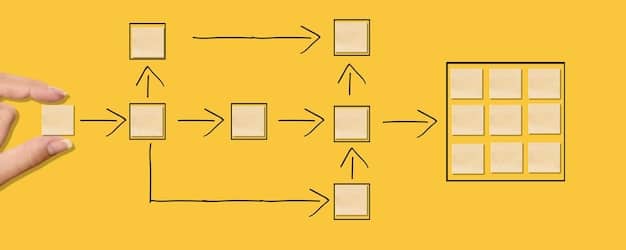Batch Processing: Boost Productivity & Efficiency by 30%

Batch processing groups similar tasks to run together, minimizing interruptions, optimizing resources, reducing idle time, and increasing overall productivity by up to 30%.
Are you constantly juggling multiple tasks, feeling overwhelmed and unproductive? Discover how batch processing: group similar tasks to increase efficiency by 30% can revolutionize your workflow and bring significant improvements to your daily routine.
What is Batch Processing and Why Does it Matter?
Batch processing is a workflow strategy that involves grouping similar tasks and completing them in a single session, rather than addressing them individually in a scattered manner. This approach is essential for anyone looking to streamline their work and boost productivity.
By understanding and implementing batch processing, you can significantly cut down on the mental overhead of task switching and focus your energy more effectively. But how exactly does this work, and why is it so effective?
Understanding the Core Principles
At its core, batch processing is about efficiency through consolidation. It leverages the principle that starting and stopping tasks consumes more resources than continuing a similar activity once already in motion. Think of it like an assembly line where each station performs a repetitive action; the entire line becomes more effective because each station isn’t constantly retooling.
Reducing Context Switching
One of the most significant benefits of batch processing is the reduction in context switching. Every time you jump from one type of task to another, your brain requires time to reorient and refocus. By minimizing these transitions, you reduce the cognitive load and maintain a more consistent level of concentration.

Here are the key advantages of reduced context switching:
- Improved focus and concentration.
- Reduced mental fatigue and burnout.
- Faster task completion times.
Batch processing isn’t just about saving time; it’s about optimizing cognitive resources, making it an invaluable technique for sustained productivity.
In summary, batch processing matters because it directly addresses the inefficiencies of multitasking, providing a structured way to handle similar activities. It reduces mental switching costs, improves focus, and ultimately drives up productivity.
Identifying Tasks Suitable for Batch Processing
Not all tasks are created equal, and some are naturally better suited for batch processing than others. The key is to identify activities that are similar in nature and can be grouped together without requiring excessive mental retooling.
Understanding the types of tasks that benefit most from being batched can greatly improve your efficiency. Let’s explore which tasks fit the bill and how to identify them.
Grouping Similar Activities
The first step in batch processing is to identify and group activities that share common characteristics. This grouping could be based on the type of software used, the cognitive skills required, or the objective of the task.
Here are some examples of how to group similar activities:
- Email Management: Dedicate a block of time to read and respond to emails.
- Content Creation: Write several blog posts or social media updates in one sitting.
- Financial Tasks: Pay bills, reconcile bank statements, and update budgets together.
Recognizing Compatible Tasks
Compatible tasks are those that can be performed back-to-back without causing mental disruption. These tasks typically require the same tools, mindset, or environment.
Consider these compatible tasks:
- Graphic Design: Work on multiple visual assets requiring the same design software.
- Research: Gather information for several related projects in one session.
- Client Communication: Make all your scheduled calls one after another.
Grouping these types of tasks can yield significant productivity gains by minimizing the startup and shutdown costs associated with each activity.
Identifying tasks suitable for batch processing involves looking for common threads and then grouping duties by those threads. By doing so, you establish an efficient workflow strategy that reduces context switching and maximizes your focus.
Setting Up Your Environment for Batch Processing
Creating the ideal environment is crucial for optimizing batch processing. A well-prepared workspace and mindset can drastically improve focus and productivity. The goal is to eliminate distractions and set the stage for uninterrupted work.
Without the right environment, you risk losing the benefits of batch processing. Let’s explore some key elements to consider.
Physical Workspace Setup
Your physical workspace should be free from distractions and organized to support your tasks. A tidy and comfortable environment promotes concentration and reduces the urge to switch tasks due to discomfort or disorganization.
Here are ways to optimize your physical workspace:
- Declutter: Remove unnecessary items from your desk.
- Ergonomics: Ensure your chair, desk, and monitor are positioned correctly.
- Lighting: Use adequate lighting to reduce eye strain.
Digital Environment Optimization
Your digital environment is just as important as your physical space. Close unnecessary applications, mute notifications, and organize your files for easy access.
The following steps can help optimize your digital environment:
- Close Unused Apps: Reduce distractions from open programs.
- Notification Management: Turn off email, social media, and other alerts.
- File Organization: Create folders and shortcuts for quick access to necessary files.

By setting up your environment effectively, you minimize potential distractions and can concentrate better on the tasks at hand. A distraction-free environment directly translates into increased productivity.
Optimizing the environment for batch processing involves both the physical and digital spaces. Creating an organized, distraction-free setting supports a focused mindset, allowing for uninterrupted work and enhanced productivity during batch processing sessions.
Tools and Techniques for Efficient Batching
Leveraging the right tools and techniques can significantly enhance the effectiveness of batch processing. From project management software to time blocking methods, the goal is to streamline your workflow and increase productivity.
Let’s explore some essential tools and techniques that can make your batch processing efforts more rewarding.
Project Management Software
Project management software can help you organize tasks, track progress, and schedule batch processing sessions. Tools like Asana, Trello, and Monday.com offer features that support task grouping and prioritization.
The following are key features to look for in project management software:
- Task Categorization: Organize tasks by type or project.
- Scheduling: Plan and schedule specific batch processing sessions.
- Progress Tracking: Monitor the completion of batched tasks.
Time Blocking
Time blocking is a technique that involves scheduling specific blocks of time for certain activities. This method aligns perfectly with batch processing, as you can allocate dedicated time slots for performing similar tasks together.
The benefits of time blocking include:
- Structured Schedule: Create a consistent routine for batch processing.
- Improved Focus: Dedicate uninterrupted time to specific tasks.
- Increased Accountability: Adhere to a predetermined schedule.
By carefully selecting and implementing project management software and time blocking techniques, you can optimize your batch processing strategy. This strategic combination enhances organization, focus, and overall productivity.
Efficient batch processing relies on a combination of the right tools and techniques. Project management software helps in organizing tasks, while time blocking provides a structured framework for focused work. By integrating these elements, you can significantly enhance your productivity.
Overcoming Challenges in Batch Processing
Even with a well-planned approach, batch processing can present challenges. From resisting the urge to multitask to dealing with unexpected interruptions, it’s important to develop strategies to overcome these hurdles and maintain focus.
Understanding these possible challenges and finding ways to combat them is essential for consistent and efficient batch processing.
Resisting Multitasking
One of the biggest challenges is the temptation to multitask. It’s crucial to stay focused on the batch of tasks at hand and avoid the urge to switch to unrelated activities.
To resist multitasking, consider the following:
- Set Clear Goals: Define what you want to achieve during the batch processing session.
- Minimize Distractions: Turn off notifications and close unnecessary tabs.
- Reward System: Acknowledge completed batches to stay motivated.
Handling Interruptions
Interruptions can derail your focus and reduce the effectiveness of batch processing. Whether it’s an urgent email or an unexpected phone call, handling them efficiently is key.
Effective ways to manage interruptions:
- Scheduled Breaks: Plan short breaks to address emails and messages.
- Communicate Availability: Let colleagues know when you’re in a focused work session.
- Use “Do Not Disturb” Mode: Block notifications during critical tasks.
By effectively managing multitasking temptations and handling interruptions efficiently, you can optimize your outcomes. Addressing these common hurdles directly leads to greater productivity and success.
Overcoming challenges in batch processing requires discipline and strategic methods. By resisting the urge to multitask and developing effective methods to handle interruptions, you can maintain focus and benefit.
Measuring and Optimizing Batch Processing Effectiveness
To ensure that batch processing is truly working for you, it’s crucial to measure its effectiveness and make ongoing optimizations. Tracking metrics like task completion time and perceived productivity can provide valuable insights for improvement.
Let’s explore some key strategies for gauging and refining your batch processing workflow.
Tracking Task Completion Time
One of the most direct ways to measure the effectiveness of batch processing is to track how long it takes to complete a set of tasks. Compare the time taken when tasks are batched versus when they are handled individually.
Key metrics to monitor:
- Average Completion Time: Calculate the average time per task in a batch.
- Task per Batch: Keep track of how many tasks are completed per batch.
- Time Savings: Determine the time saved by batching tasks.
Assessing Perceived Productivity
Beyond quantitative data, it’s important to assess how productive you feel when using batch processing. A survey or reflection journal can provide valuable insights into your subjective experience.
Questions to ask:
- How focused did you feel during the batch processing session?
- How much mental fatigue did you experience?
- Overall, how productive do you feel the batch processing sessions went?
By regularly measuring and optimizing the effectiveness of your approach, you can ensure that it continues to deliver. This ongoing refinement is key to unlocking the full potential of batch processing.
Measuring and optimizing effectiveness requires a combination of quantitative tracking and subjective assessment. By monitoring completion times, perceived productivity, and making data-driven adjustments, you can refine your approach and enhance its benefits.
| Key Point | Brief Description |
|---|---|
| 💡 Definition | Grouping similar tasks to enhance efficiency and minimize context switching. |
| 🎯 Suitable Tasks | Tasks that are similar in nature and don’t require excessive mental retooling. |
| 🛠️ Tools & Techniques | Project management software and time blocking. |
| 📈 Effectiveness | Track task completion time and assess perceived productivity. |
Frequently Asked Questions
▼
Batch processing involves grouping similar tasks together to complete them in one session, minimizing interruptions and increasing focus. This technique greatly improves efficiency and reduces the mental overhead of task switching.
▼
It minimizes context switching, reduces mental fatigue, and improves focus by allowing you to dedicate uninterrupted time to similar tasks. This focused approach can lead to significant productivity gains and higher-quality work.
▼
Tasks that are similar in nature, require the same tools or mindset, and can be performed consecutively without causing mental disruption are best suited for batch processing. Examples include email management, content creation, or financial tasks.
▼
Ensure your physical workspace is organized, clutter-free, and ergonomic. In your digital environment, close unnecessary applications, mute notifications, and organize your files for easy access. This setup minimizes potential distractions.
▼
Project management software like Asana or Trello can help organize and schedule tasks. Time-blocking techniques can also structure your day by allocating specific time blocks for batch processing. The right tools can significantly boost productivity.
Conclusion
By understanding and implementing the principles of batch processing: group similar tasks to increase efficiency by 30%, you can transform your workflow and see significant improvements in your productivity. Start by identifying suitable tasks, optimizing your environment, and leveraging the right tools, then measure your progress and continuously refine your approach. The result will be more focused, productive, and efficient work habits.





